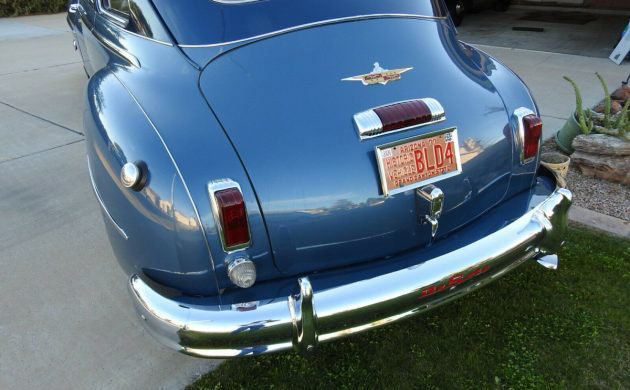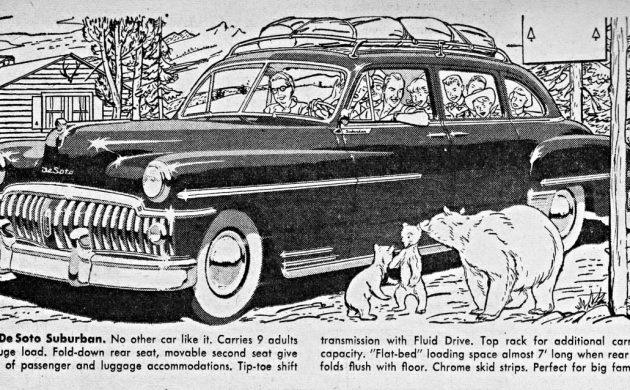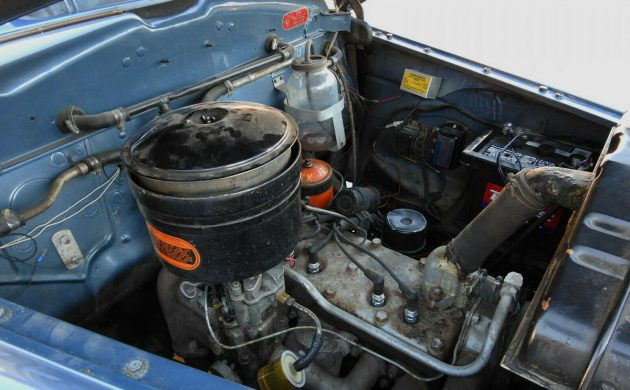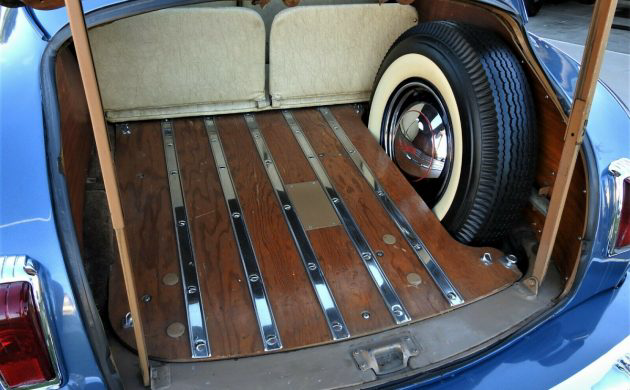It wasn’t only General Motors that built Suburbans. In 1948, DeSoto offered this really cool eight-passenger vehicle. It’s here on eBay in Glendale, Arizona with a $60,000 Buy It Now.
There’s a lot of utility vehicle here, although it’s not technically a “Woodie” as the ad states. There’s no exterior wood, though the interior is richly paneled. Apparently, this treatment went by “inside-out Woodie.” But even without visual surfer cues, with its subtle two-tone blue paint, this vehicle exudes serious cool. The paint is the only thing that was refreshed—otherwise, the owner says, the DeSoto is all original. There are only 1,750 miles on the odometer. The leather seats are beautifully patinaed, but not dried out or cracked.
Says the vendor, “This DeSoto runs and drives with ease, very solid car, other than a little detail work under the hood it looks as it is a new car! The gentleman who owned this car had an awesome collection of Woodies, and this unusual ‘Inside-out’ Woodie added a unique perspective to his collection. It was at one time in a special display at the Petersen Museum in California. It can now be added to your collection.”
Museum curation would explain the vehicle’s condition, and lack of use. The vendor again: “The Suburban was a continuation of DeSoto’s long-wheelbase models, first introduced in 1946. The Suburban differed from other DeSotos in that the four-door sedan rode a 139.5-inch wheelbase chassis, creating a car that was capable of carrying eight passengers (the ad above says nine) as shipped from the factory. The car accomplished this eight-passenger capacity through the use of factory-installed jump seats. At nearly seven feet long, DeSoto claimed the fully-deployed cargo floor sleeps two easily. Even with the second row in use, the trunk is more than five feet long.”
Hotels used cars like this to transport guests, as did airports. But if this one had either use, the mileage would be much higher. It does have the optional rooftop luggage rack, suggesting it was in the people mover business—however briefly. We’re assuming the original Chrysler inline “Powermaster Six” engine is still in place. It generated 109 horsepower, so progress was and will be leisurely—zero to 60 in 21.8 seconds. The top speed was 76 mph.
There were three models, Deluxe, Custom, and Powermaster—not sure which this one is, but its appointments suggest it was upper spec. A word about the “Fluid Drive” transmission, courtesy the vendor: “The shift pattern on a Fluid Drive car has only a reverse position (in and up); a second gear position, low (out and up); and a third gear position, high (out and down). The first gear position was eliminated. In the out and up gearshift position, which is low, there are two speeds and there are two speeds in the out and down gearshift position, which is high. The clutch is needed to initially engage the trans in any of the gears—reverse, low or high. After that, the clutch is only needed to remove it from gear or from going from low to high position while driving. You can start in either the low or high position. Very interesting concept! And it is fun to drive!”
The car carries a clear Arizona title. I’m sure you creative folks can think of great uses for this wagon. It would make an ultra-sweet transporter for a country swing band—even if they have a horn section.









See the world in a Happy Daze.
Mr. Cunningham’s Desoto was a standard sedan, but nearly this same color!
There is nothing true, than the saying, Someone’s TRASH, is someone’s TREASURE. Like the member, below, Angliagt, said, “has no appeal to him” bit I would love to have an all original DeSoto from the 40s. A work of ART & ENGENEERING, it makes today’s cars look like plastic buckets on wheels. John I in Boston 978 930 7435
These have almost no appeal to me.
Kind of ugly,slow, & bloated.
That said,looks to be in really good shape.
Now I see a breathtaking car just waiting for an 8 passenger 500 mile road trip.
Another beautiful car. I never heard of the wild shift pattern stated above. Very cool and we learn such neat stuff here at BF. I hope it goes to a good home. That is a lot of car…
As a kid, I would have agreed with angling. As an adult, I think they are pretty cool.
My father had a ’52 Dodge with fluid drive. That was the closest he got to an automatic transmission back then.
This is one inch shorter in length and four inches narrower than a 2022 Chevy Suburban. When the kids were young was thinking of getting a limo instead of a minivan. I think this would have even been better. No more “dad he’s touching me”.
Price drop to $49k. Pretty spectacular car, but the seats look a bit out of place. Maybe re-do in some vintage plaid?
There were three transmissions available. 1)Three speed manual. 2)Three speed with fluid drive. This is the same transmission with a fluid coupling, somewhat similar to a torque concerter, instead if a dry clutch. You could stop at a light without depressing the clutch, as the fluid coupling would slip. 3) Chrysler Corp semi automatic 2 ranges of 2 speeds each. You used the clutch pedal to select a range (Almost always the high range} At a falrly low speed you would lift off the gas pedal and WAIT. There would be a loud clunk, and the transmission would shift up once. If you wanted low range, which was really low, you had to use the clutch pedal to select it.
Not only was the shift pattern wonky, there is no shift quadrant or visual guide to what gear you are in. My Father had a 1948 Desoto Convertible (the first car I remember), which was traded on a new 1951 Dodge Wayfarer Convertible with fluid drive. A red light runner totaled it and its replacement was a 1951 Dodge Diplomat 2 dr hardtop with Gyromatic,(Dodge’s name for the 4 speed semi automatic). The fluid drive Dodge was slow, the Gyromatic version was glacial.
All Par went into great detail on the semi automatic.
from the Nick Alexander collection?
It looks like it possesses something that has not been mentioned. A close-up look would satisfy me on the wheels. Years ago, I ordered a set of NOS Whitewall Beauty rings that were Porcelain Painted White for my 47 Chevy thinking they would fit my chevy, but they were for Chrysler, 16 inches in size. and were on a lot of cars in this era to resemble Whitewall Tires. Looks like this car has a set of them on it. I still have them wrapped in paper and in the box.
A very large number of Chrysler products right after WWII had these whitewall rings on them. Tires, especially whitewalls, were still in short supply. By the early 50s, the fad had gone and REAL whitewalls appeared again.
Eight passengers and one driver makes nine people.
From the mid eighties to the late nineties I had a 1950 Desoto Custom sedan with Fluid Drive. The transmission operated as Ben T Spanner described. As I remember the up shift from low to high was more of a Click than a Clunk and not particularly loud either. It was able to take off from a stop reasonably quick enough but best to keep right until she got rolling in high. Cruise for hours on the interstate at 65-70 no problem.
My Uncle had a 48 Chrysler 4 dr W/fluid drive, and it would “clunk” sometimes when shifting, was ok when newer but by the time it got some miles needed a overhaul so was slow.
At age 11 in 1951, I and many other boys my age were alter boys at Our Lady Of Sorrows Catholic Church in Santa Barbara, Ca. As a reward for being good alter boys, we went on trips to the beach in the parish’s Desoto, a really nice big car. Probably a dozen of us with a Father driving. For larger events we had a 1947 Ford bus which sat about 30 kids. Good times had by all.
I also remember the Yellow Cabs in LA were all Desoto Suburbans being pushed to the limit.
Got my introduction to fluid drive when my late friend Irwin (Tex) Garber bought a ’41 Chrysler he found behind the service station where he worked for @$20. mop painted and missing the rr fender. Both 15 in that summer of ’61 and not legal until October of that year, we cruised Chicago sans license, vehicle sticker or insurance and a borrowed rear plate (he drove of course). Never caught and once legal the thrill was gone.
Bit of a typo on the BF write up, it doesn’t have 1.7k miles on it, it has 17,504.
Two connections for me and this car: When I was born we had a ’49 New Yorker with Fluid Drive and I remember when my dad had to take it apart and repair it. Everything was separated into coffee cans in the garage.
My second connection was regarding my first convertible, a ’68 VW. When I bought it the thing was wearing whitewall rings. I kept them on the entire time I had the car and even when I replaced the tires. They were quite convincing.
I had a 1951 De Soto with the tiptoe shift fluid drive very simple to drive slower than a slug but a head turner I owned it for about two years and drove the wheels off of it original six lots of fun
Everyone has commented on the fluid drive in this car, but my first thought was that as a kid in Brooklyn and Manhattan, half of the taxi cabs were Dodge and Desoto long wheel-base cars just like this one (very few Chryslers and Plymouths, and I don’t believe that the latter had a long wheel-base model).
my older brother had a 1948 DeSoto sedan. Very cushie upholstery. Ran very smooth. The fluid drive was much better in snow than a “Stick” shift. What was neat was the speedometer. It would glow Green under 50 mph, then got to Yellow and if too fast it went to red. I remember thinking that all cars should have that feature. Very reliable car.